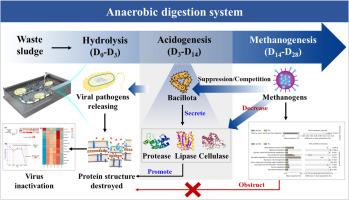Functional Microbial Communities in the Hydrolysis-Acidogenesis Stage Promote Sludge Viral Inactivation under Anaerobic Digestion
IF 12.4
1区 环境科学与生态学
Q1 ENGINEERING, ENVIRONMENTAL
引用次数: 0
Abstract
The sludge produced in biological wastewater treatment enriches enormous viruses, and the pathogens inactivation is vitally important for protecting public and ecosystem health. Anaerobic digestion (AD) is an ideal bio-stabilization technology to reduce sludge volume and convert nutrients into valuable products, but the compositional variation and host-connections of viruses in sludge during AD process remains poorly explored. Herein, we reported differences in the viral and bacterial microbiomes of sludge subjected to three stages of hydrolysis, acidogenesis and methanogenesis in AD system. As results, the dominant identified viromes phylum associated with animal/plant as hosts were Nucleocytoviricota, Pisuviricota and Preplasmiviricota excepted for phages in AD system; and the metatranscriptome combined with key species-virus activity correlation analysis revealed these viral community inactivation was positively correlated to phyla of Bacillota, Actinobacteria Bacteroidetes and Proteobacteria. Thus, the enzymes of cellulase, proteases and lipases were possible key factors in viral inactivation, which would be increased by secreting of Bacillota and Actinomycetota in hydrolysis-acidogenesis stages, leading to higher virus inactivation via membrane proteins destruction; while enhanced activities of methanogens communities in methanogenesis stage completed and suppressed the Bacillota activities, resulted in viral genes replication and higher residual viral abundance in sludge. These findings gave more insights of relationships between functional microbiome and viral survival in sludge of AD process, and provided important scientific guidance in regulating microbial community structure of AD system to ensure the safe management of sludge in pandemic emergencies.

水解-酸发生阶段的功能微生物群落促进厌氧消化下污泥病毒灭活
废水生物处理过程中产生的污泥中含有大量的病毒,其灭活对保护公众和生态系统的健康至关重要。厌氧消化(AD)是一种理想的生物稳定技术,可以减少污泥体积,将营养物质转化为有价值的产品,但在厌氧消化过程中,污泥中病毒的组成变化和宿主连接尚不清楚。本文报道了AD系统中经过水解、产酸和产甲烷三个阶段的污泥的病毒和细菌微生物组的差异。结果表明,在AD系统中,除噬菌体外,与动物/植物相关的主要病毒体门为核病毒门、腺病毒门和前质病毒门;超转录组结合关键种-病毒活性相关性分析显示,这些病毒群落失活与杆菌门、放线菌门、拟杆菌门和变形菌门呈正相关。因此,纤维素酶、蛋白酶和脂肪酶可能是病毒失活的关键酶,在水解-酸化阶段,杆菌门和放线菌门的分泌会增加病毒的失活,从而导致病毒通过破坏膜蛋白而失活;而产甲烷菌群落在产甲烷阶段的活性增强完成并抑制了芽孢杆菌的活性,导致了污泥中病毒基因的复制和较高的残留病毒丰度。这些发现进一步揭示了AD工艺污泥中功能微生物群与病毒存活之间的关系,为调整AD系统微生物群落结构,确保突发疫情中污泥的安全管理提供了重要的科学指导。
本文章由计算机程序翻译,如有差异,请以英文原文为准。
求助全文
约1分钟内获得全文
求助全文
来源期刊

Water Research
环境科学-工程:环境
CiteScore
20.80
自引率
9.40%
发文量
1307
审稿时长
38 days
期刊介绍:
Water Research, along with its open access companion journal Water Research X, serves as a platform for publishing original research papers covering various aspects of the science and technology related to the anthropogenic water cycle, water quality, and its management worldwide. The audience targeted by the journal comprises biologists, chemical engineers, chemists, civil engineers, environmental engineers, limnologists, and microbiologists. The scope of the journal include:
•Treatment processes for water and wastewaters (municipal, agricultural, industrial, and on-site treatment), including resource recovery and residuals management;
•Urban hydrology including sewer systems, stormwater management, and green infrastructure;
•Drinking water treatment and distribution;
•Potable and non-potable water reuse;
•Sanitation, public health, and risk assessment;
•Anaerobic digestion, solid and hazardous waste management, including source characterization and the effects and control of leachates and gaseous emissions;
•Contaminants (chemical, microbial, anthropogenic particles such as nanoparticles or microplastics) and related water quality sensing, monitoring, fate, and assessment;
•Anthropogenic impacts on inland, tidal, coastal and urban waters, focusing on surface and ground waters, and point and non-point sources of pollution;
•Environmental restoration, linked to surface water, groundwater and groundwater remediation;
•Analysis of the interfaces between sediments and water, and between water and atmosphere, focusing specifically on anthropogenic impacts;
•Mathematical modelling, systems analysis, machine learning, and beneficial use of big data related to the anthropogenic water cycle;
•Socio-economic, policy, and regulations studies.
 求助内容:
求助内容: 应助结果提醒方式:
应助结果提醒方式:


